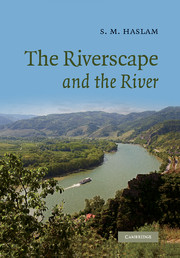Book contents
- Frontmatter
- Contents
- List of tables
- Preface
- Acknowledgements
- 1 Introduction
- 2 The natural river and its destruction
- 3 The natural riverscape and its modification
- 4 Resources I. Water resources and their loss
- 5 Development and variation of rivers
- 6 Development and variation of riverscapes
- 7 Building blocks of river vegetation
- 8 Building blocks of flood plain vegetation
- 9 Resources II. Plants and animals, cleaning and minerals
- 10 Building blocks of the riverscape
- 11 Patterns, boundaries and fragmentation
- 12 Resources III. Settlements and constructions
- 13 The harsh riverscape
- 14 The tempered or smiling riverscape
- 15 Envoi
- Bibliography
- Index to plant and animal vernacular and taxonomic names
- General subject index
7 - Building blocks of river vegetation
Published online by Cambridge University Press: 10 August 2009
- Frontmatter
- Contents
- List of tables
- Preface
- Acknowledgements
- 1 Introduction
- 2 The natural river and its destruction
- 3 The natural riverscape and its modification
- 4 Resources I. Water resources and their loss
- 5 Development and variation of rivers
- 6 Development and variation of riverscapes
- 7 Building blocks of river vegetation
- 8 Building blocks of flood plain vegetation
- 9 Resources II. Plants and animals, cleaning and minerals
- 10 Building blocks of the riverscape
- 11 Patterns, boundaries and fragmentation
- 12 Resources III. Settlements and constructions
- 13 The harsh riverscape
- 14 The tempered or smiling riverscape
- 15 Envoi
- Bibliography
- Index to plant and animal vernacular and taxonomic names
- General subject index
Summary
The public perception of river corridors and the conservationists' understanding may differ greatly
River architecture
Rivers vary in their structure, their architecture (Fig. 7.1). This structure is, firstly, that which surrounds the water: the bank, bed, rocks, shoals, vegetation and its shade, together with artefacts such as bridge piers, weirs, mill-wheels and altered banks. The natural structures are due to the factors already discussed: land form, geomorphology, discharge, erosion, sedimentation, rock type (Chapters 3 and 5). These are then modified by engineering, trampling livestock, burrowing animals, boats, anglers, constructions and other activities.
Plants are influenced, often controlled by this inorganic structure. They grow because of, by, in and over it … or avoid it, as the case may be. The presence of some plants may also influence the structure of others (Chapter 5).
For fish, the vegetation is as much part of the river architecture as is the gravel in the bed. Some invertebrates live just on plants: plants are their river structure. The same applies to some diatoms and other periphyton.
The identity of ‘structure’ therefore varies with the organisms using it. Substrate structure is the most important building block in mountain and rocky streams, indeed may be the only sizeable building block in really swift water. But in lowland streams the gentle, earthy substrate is also a vital building block.
- Type
- Chapter
- Information
- The Riverscape and the River , pp. 157 - 178Publisher: Cambridge University PressPrint publication year: 2008

